Rising water levels have turned up the heat for fishers in southern Queensland dams. The increasing water volume has really improved the quality and quantity of recent catches in Somerset and Maroon.
Somerset and Maroon dams are miles apart in more ways than one but at the moment they would seem to be completely in-tune with each other. Both have received a huge influx of freshwater and both dams are on fire – bags of 30 bass in an afternoon not being a hard target to achieve.
Somerset and Maroon, apart from both having bass, have little similarities. In Somerset, the main food source for bass is bony bream that school-up throughout the water column. In Maroon, the bass chow down on anything they can catch from gudgeons to little black beetles on the surface. These are all found around the weed edges compared to the deep schooling bass of Somerset.
Nevertheless, after the recent rise in water levels the two dams are fishing almost identically. By watching the bass’ attitude and positioning on the fish finder you wouldn’t be able to tell the difference.
The bass in Somerset usually catch on quickly that there is now an extra food source for them up near the edges. The gudgeon and red claw get their homes flooded, which in turn means a reaction bite for anglers.
It is best to search an edge bite for a reaction strike using lipless vibration lures and spinnerbaits. It is difficult to beat the sensation of a hard-hitting bass smash your lure and nearly rip the rod from your grip.
After a big down pour it pays to wait two weeks for the water level to settle and give the bass time to move up into the shallows and get acquainted with their new hunting grounds.
Having patiently waited two weeks for Somerset’s recent levels to settle it was time to tackle some of these monster bass. Fishing with good friends, Glynn and Simon Barkhuizen, I knew that between the three of us we would be able to cover a lot of different techniques in order to find what the bass are eating.
On arriving to the dam, we were amazed to see just how high it had actually risen. Both the boat ramps at the spit and Kirkleigh’s ramp were now completely in the water.
Looking for the edge bite, we all had some style of reaction lure set up. We headed to the banks that we knew had produced fish on previous water rises.
The first bank we stopped at produced only one yellowbelly. The next spot wasn’t much better, with a tiny 20cm bass in the net. However, it did give us hope that if one bass was around there would surely be more. But after continuing for quite a while we didn’t even receive a bump.
Simon decided to head further up the dam and try his luck. No sooner had he cast his spinnerbait into the water, when the end got smashed. The fish stripped drag from his reel and then suddenly stopped struggling. Reeling in the line, up came a silver perch attached to the stinger hook on his spinnerbait – great catch, but it wasn’t a bass.
Feeling a little down spirited, we decided to search up near the timber, as the bass would now be able to access it. We made the long haul up to the sticks with caution, as there would be plenty of submerged objects that could damage the boat.
Alas, we just about wore the paint off our lures catching only thistles and long pieces of green grass. Starting to get a bit deterred we decided to head back to the main basin for some lunch. On the way back we thought we would hit one last bank. At last we had success! Within five casts I was on to a nice bass.
Simon decided to cast a Smatra vibration lure and his second cast had him fighting a nice bass to the boat. This continued until Simon’s lure was eventually smashed, which had him striking back hard and popping his leader and losing the lure.
After that fun, but short, session we went in search of schooled fish in all the usual haunts. We drove around watching the sounder for those tale-tell signs of bass. We figured that the water rise had to have some impact on the fish, so we decided to start at the bank and work our way out deeper.
At about 15-25ft the sounder was thick with arches – the sign of good bass holding. We tried all means of reaction lures and heavy plastic vibration lures with different styles of retrieve. Eventually, a simple ice jig did the trick, with Glynn’s reel screaming off with a big, angry bass on the end of the rod.
It’s amazing how hard it is to tie lures and leaders on when there is a sounder full of bass and you have just worked out what they want to eat. We spent the rest of the afternoon hooking and releasing almost 30 bass longer than 40cm, and the biggest being just shy of the magic mark of 50cm.
We found the most active fish were out in 30ft of water and sat suspended at 15ft. Slow rolling 3” paddle-tail plastics on 1/2oz jigheads brought these fish undone. Instead of the typical gentle taps of the lure, the bass were smashing it and ripping line off at a great rate of knots when hooked.
Most of the fish had the plastic deep down their throat, which took its toll on our leaders. Some fish even snapped the line almost instantly due to a combination of the hard hit and their abrasive jawbone.
Overall the Somerset session took a while to get started, but once we located the fish it turned into a ripping afternoon.
As I live close to Maroon, I’m lucky enough to have spent many fishing trips on the lake. I just love the fact it is full of hard-hitting bass that demolish lipless vibrations almost cast after cast. My favourite part of Maroon is that these angry bass annihilate surface lures the instant the sun is off the water. This turns a great afternoon outing into an unbelievable evening session.
The way I usually approach Maroon is to pick a bank away from the wind and sit the boat just short of a cast length away from the weed edge. I then cast lipless vibrations at the weed, pulling them short of the edge, and letting them fall down the face with a slow roll back to the boat. The lure rarely makes it more then 10ft from the weed before being demolished by an enthusiastic bass.
After the recent rise in Maroon, almost 30ft of water, I was keen to work out where the bass would now be holding. The first place to try would be the usual fish holding banks.
As there was no weed edge to target, my aim was to land the lure close to the bank and start the retrieve instantly. I would then slowdown the retrieve as the lure approached the deeper water to keep it close to the bottom and in the strike zone.
A couple of the fish came the second the lure hit the water, even before I had clicked my reel into gear, then other fish came half way back to the boat. A fish snagged my lure on the bottom in 15ft of water and, after some backward and forward struggling, the snag broke free and I brought up a nice sized bass.
After a couple of hours, catching ten bass, we discovered there was no real pattern to their positioning. The catch rate was down significantly from previous trips, so we decided it would be worthwhile checking out previously marked spots.
I drove slowly towards the marks watching the sounder for any signs of life. As I neared a spot, I noticed a couple of fish suspended at midway in 30ft deep water. I turned the main motor off and progressed with the electric, watching the sounder for more fish. As the weed bed started to show on the bottom of the screen so did the fish – it was now full, all the way from 15-25ft with bass.
I casted my lipless vibration lure out across the marked area and let it sink for ten seconds before slowly rolling it back towards the boat. Within four turns of the handle my lure was obliterated by a bass. I unhooked and released it and then repeated the process with equal success – it was awesome. We caught almost 60 bass that afternoon just sitting in the one spot casting out across the school.
The Maroon bass aren’t as big as Somerset with a big fish being 39cm to the fork, and the average being 30cm. But what they lack in size they more then make up for in their ability to destroy your lures. They rip drag from your reel still under the energy of the initial hard-hitting strike.
The influx of freshwater has been awesome for the future of these dams and is also great for making the bass go into a feeding frenzy.
Fact box 1
Gear Box for Somerset Dam
| Rod: | Megabass F1 Destroyer 6”9’ |
|---|---|
| Reel: | Shimano Stella 1000 |
| Mainline: | 11lb Unitika Power Jigging Deluxe |
| Leader: | 10lb Unitika Aiger III fluorocarbon |
| Lures: | 1/2oz TT depth charge jighead with 3” green paddletails. |
Fact box 2
Gear Box for Maroon Dam
| Rod: | Megabass F3 Destroyer 6”5’ |
|---|---|
| Reel: | Shimano Scorpion 1000 |
| Mainline: | 15lb Unitika Power Jigging Deluxe |
| Leader: | 14lb Unitika Aiger III fluorocarbon |
| Lures: | Megabass Smatra in GG Kin-Buna colour |
(1. and 2.)
Reads: 4772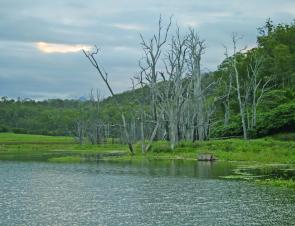
Maroon before the influx of wet weather.
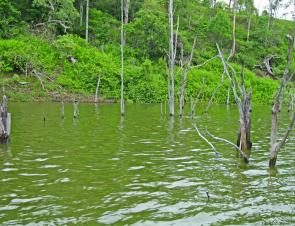
The dam is unrecognisable after the increase in water level.
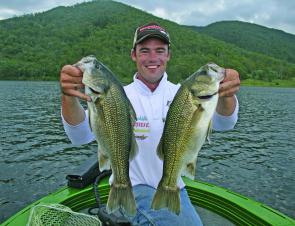
Somerset may not produce a plentiful supply of bass, but it certainly produces good sizes. Here are two catches at 49cm each.

Maroon bass just can’t resist a lipless vibration lure.
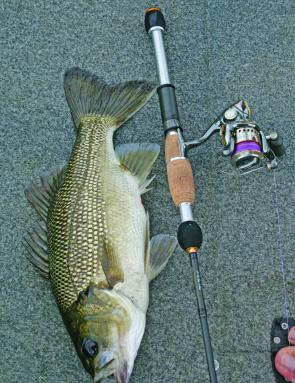
This Somerset bass was smashing the lure so hard that the soft plastic was found deep down its throat.
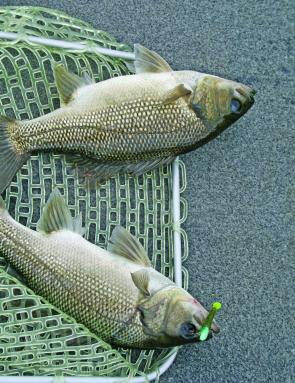
Unlike Somerset, Maroon produces a large amount of bass. Two in the net was a familiar sight all afternoon.




